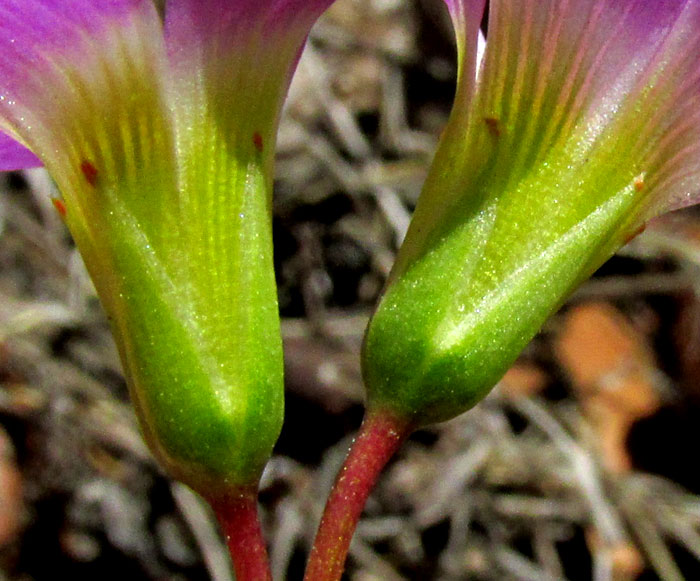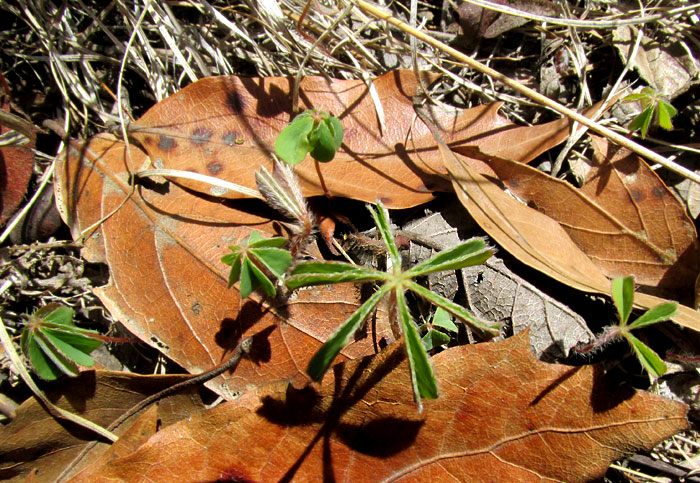Excerpts from Jim Conrad's
Naturalist Newsletter
entry from field notes dated July 2, 2022, taken on Cerro de la Cruz, at an elevation of ~2885m (~9465 ft), just south of the community of El Pinar, Amealco de Bonfil, Querétaro, MÉXICO, (~N20.17°, ~W100.17°)
OXALIS HERNANDESII

In an oak forest on the lower, eastern slope of Cerro de la Cruz, the above woodsorrel, or oxalis, flowers -- larger than those of the usual species -- emerged from a steep slope's tangle of drought-dead grass and last season's oak leaves. Of the over 550 species of of oxalis known to exist, in our dry, upland region of central Mexico known as the Bajío, 14 have been documented. Species in the genus can be neatly separated into those with stems, and those in which flowers and leaves arise directly from scaly bulbs, with no stems. The above blossoms are attached to a slender, stem-like pedicel (with no branching or nodes like a stem) so this is one with scaly bulbs. That fact alone disqualifies four of the 14 possible species.

The flowers themselves aren't very helpful in sorting out our remaining ten species. However, in the above picture you see some very vigorous looking anthers heavy with yellow pollen, but, despite the fact that oxalis flowers produce both male and female parts, there's no sign of the female stigma atop a style. I've seen very obvious stigmas and styles on oxalis flowers before, so this is interesting.
It happens that species in the genus Oxalis produce three flower types, a condition technically known as heterostyly. In oxalis flowers exhibiting heterostyly, relative to stamen length, the styles can bear their stigmas much lower, well above, or half the height of the stamen's anthers. Making the situation even more interesting is that these physical differences are related to differences in chemistry, which limit the effectiveness of pollination between like types, diminishing the probabilities of cross pollination between the different flower types, even though they're all the same species. Well, these insights lead to more and more questions and insights but, in the field, when you see something like this all you can do is to grin and pay more attention to more details:

The flowers' calyxes were normal looking, with brown, wart-like swellings at the tips. With what's been seen so far, we still are unsure which of the remaining ten species we have. Fortunately, just a foot or so away, leaves obviously of an oxalis were emerging from the grass and oak-leaf tangle:

Most oxalis species I know produce clover-like compound leaves with only three leaflets. Here the big leaf in the center displays six, while other leaves show five, four and three. Even though the leaflets aren't yet fully open so we can see their natural form, this is a big help. Of the ten remaining possible species, the leaves of seven species produce leaves with only three or four leaflets, so now we're down to three possible species.

Identification of the last three species depends on how deeply each leaflet is indented or cut at its outer end. In the above picture one leaflet shows us its cut, which is very shallow. Of the three eligible species, the leaflets of only one has indentations less than one-tenth of the leaflet's length, and that species is OXALIS HERNANDESII.
Oxalis hernandesii is known by no English name because it's endemic just to the Mexican uplands, from Sonora and Chihuahua south to Chiapas. It occupies habitats ranging from abandoned fields to fir forests, at elevations of 1700-3100 meters (5500-10,200 ft). The species's leaflets can vary in number from three to thirteen. Our pictures show conspicuously long hairs on the leaves, but some plants are hairless.
In H.S. Gentry's 1942 classic of botanical literature, The Río Mayo region of northwestern Mexico, it's reported that people there used Oxalis hernandesii for toothaches. Beyond that, I assume that this species can be used like the many other oxalis species whose soft leaves contain high levels of oxalic acid: Their sour taste goes well in a salad, and in traditional medicine their acid content can help dissolve kidney stones.